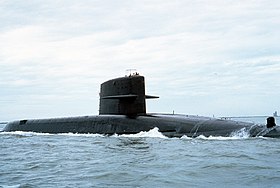USS Lewis and Clark (SSBN-644)
 The Lewis and Clark 1991 at sea |
|
| Overview | |
|---|---|
| Order | November 1, 1962 |
| Keel laying | July 29, 1963 |
| Launch | November 21, 1964 |
| 1. Period of service |
|
| Commissioning | 3rd December 1966 |
| Decommissioning | June 27, 1992 |
| Whereabouts | Canceled |
| Technical specifications | |
| displacement |
8250 ts submerged |
| length |
129.5 m |
| width |
10.1 m |
| Draft |
9.6 m |
| crew |
13 officers and 107 men |
| drive |
A S5W reactor |
| speed |
25+ knots |
| Armament |
4 533 mm torpedo tubes , 16 ICBMs |
The USS Lewis and Clark (SSBN-644) was a nuclear-powered submarine of the United States Navy of the Lafayette-class and belonged to the subclass Benjamin Franklin on. The boat was a so-called Ship Submersible Ballistic Nuclear , a submarine specially designed for launching ICBMs . It was named after the Lewis and Clark Expedition and their leaders Meriwether Lewis and William Clark .
history
SSBN-644 was commissioned from Newport News Shipbuilding on November 1, 1962 and laid down there in the summer of 1963. After almost a year and a half, the boat was launched and christened, and at the end of 1965 the Lewis and Clark was finally put into service.
In the summer of 1972 the boat finished converting its missile bays, before that the boat could shoot down the UGM-27 Polaris , and later the more modern UGM-73 Poseidon . On December 18, the Lewis and Clark shot down a Poseidon for the first time in the test . In 1981 the boat first shot down four more missiles and then docked in their original shipyard to be overhauled there.
In 1985 the SSBN shot down another four Poseidon on a test basis, on June 27, 1992 the boat was finally taken out of service and canceled until 1996 in the Puget Sound Naval Shipyard as part of the Ship-Submarine Recycling Program .
The Lewis and Clark's turret and elevator were preserved and are now on display at the Patriots Point Naval and Maritime Museum in Charleston , South Carolina .